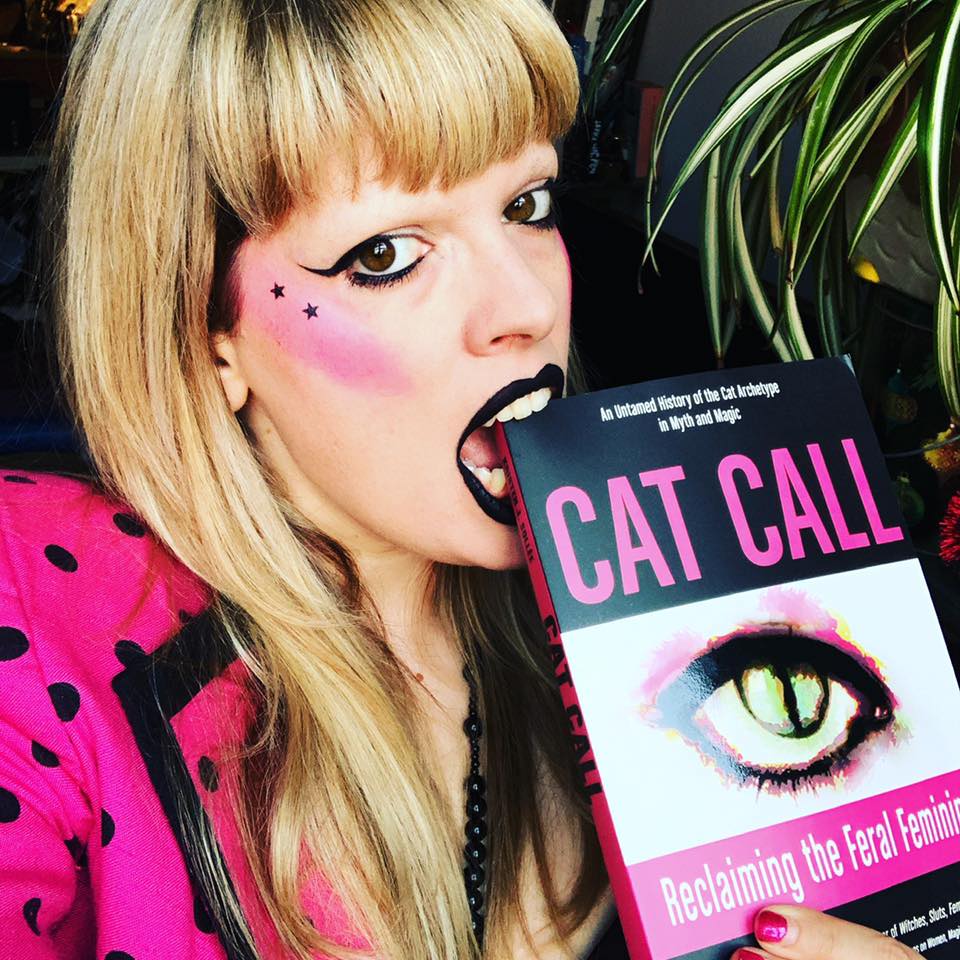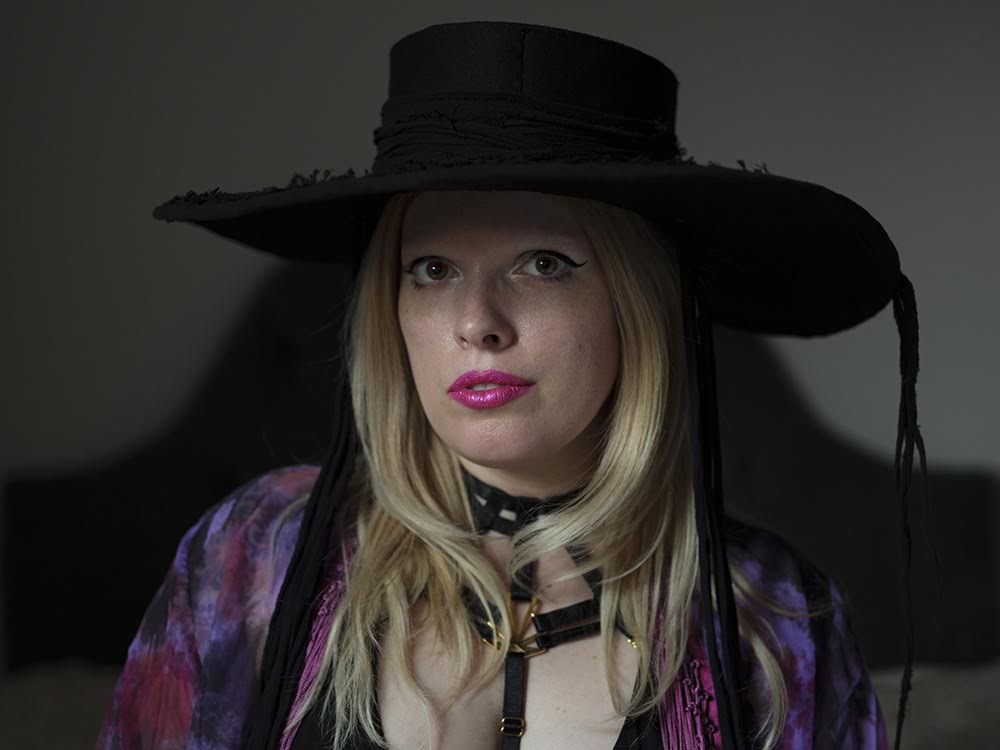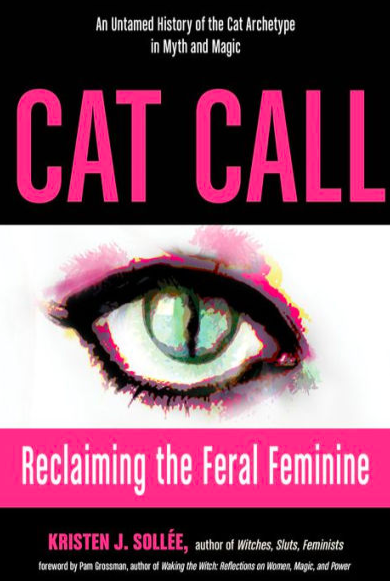|
Interview by Ana Vice Kristen J. Sollée’s most recent book, Cat Call, explores the cat archetype, feral feminine, and the allure of the cat throughout history. Here, in an intimate interview, she discusses the power of feline glamour magic, female sexuality and cat kink, as well as demystifying the so-called “cat lady” trope. Ana Vice: Why name your book Cat Call and what can readers expect to get out of this book? Kristin J. Sollée: Two reasons: First, to reclaim something negative from patriarchal clutches. The “cat call” is most often an utterance on the street directed towards female bodies that lauds, critiques, and polices those bodies. Second, it’s like the way cats call to me. It is the pull of the feral feminine and the magic of cats and feline energy. I wanted to play on those two things. It is definitely a feminist book, but also a magical book – and those things go hand in hand for me. Ana: Could you tell us more about the politics of liberation and the cat archetype? Kristen: You can’t separate this new wave of feminism and the popularity of the witch archetype from our ideas about cats and cat ladies. Cats and witches are inextricably tied to women and femininity, and feminism is the best theoretical framework we have to address the associations between cats, witches, and women and the political implications at play when you’re talking about this trifecta. Cat iconography has been used in Leftist and liberal politics for decades, from the Industrial Workers of the World’s “sabo-tabby” to the pussy hat. It makes sense that movements looking to liberate people from class or gender oppression or the chains of capitalism would think of the feline as a model of aspirational defiance given that cats pretty much have no gods and no masters. Ana: How do you define the “feral feminine”? Kristen: The feral feminine is a nebulous concept. It’s slippery. It’s a femininity that is not necessarily attached to any one kind of human body, but is definitely linked to feline bodies for sure. The feral feminine is a femininity that is not controlled; it’s bodily autonomy, freedom of sexual expression, it’s a response to the way femininity has been denigrated throughout history. It’s taking femininity back on our own terms by looking to the cat for inspiration. I think we can look to Catwoman as an icon of the feral feminine, or the shape-shifting vampiress Carmilla and the female protagonists of the classic Japanese horror film Kuroneko. It’s basically femininity with bite and women who aren’t afraid to engage their claws. Ana: Which Goddesses are associated with cats? Kristen: Bast (Bastet), Isis, Freya, Durga. Also possibly Artemis who was once said to shapeshift into a cat. And then – this is not a goddess but more of a fairy or witch – the Cat Sidhe of Celtic mythology. There could be a whole second book about the magical and spiritual workings you can do with cats and feline deities, since Cat Call is not a how-to per se. Ana: I perceive Cat Call as a definite gateway into deeper insights and spiritual workings with cats and feline deities. Kristen: I’m glad! I’m honored because I wanted that and I also wanted to appeal to people who just were into intellectual stimulation without the spiritual aspect. As far as what you can do to work with these goddesses or energies, I think using cat amulets, charms or figurines as jewelry or magical objects on your altar is one simple way. I personally have a little black obsidian cat in my home watching over me from a high place. I have all kinds of cat jewelry. I think even doing simple sympathetic magic (by having these things on you or in your home) can draw powerful feline energy in. The power of wearing something that mimics feline coats allows you to take on feline power. Ana: In the book you discuss transformation by way of appearance and make mention of the cat as a shapeshifter. Could you tell us more about the significance of this? Kristen: For me, I’m an animal prints wearer, particularly leopard or tiger prints. They make you feel powerful! I quote Jo Weldon in the book (who wrote Fierce: The History of Leopard Print) about how leopard print signifies you’re definitely not prey. You may not be a predator, but you’re not prey either. Then you take that a step further and there’s the magical aspect, again going back to sympathetic magic. The power of wearing something that mimics feline coats allows you to take on feline power. You don’t need to literally wear cat skin to take that energy on (although many of our ancestors might have for magical practices long ago), but it can be really transformative if you do it with intention. Ana: What was your fascination with Catwoman from the Batman series growing up and how did it shape you into the person you are today? Kristen: In the book I talk about wanting to dress as up Catwoman when I was about nine years old, and my interest in Catwoman inspired my interest in kink many years later. I went to my first fetish shop when I was in high school and saw all these “cat costumes” but knew they weren’t exactly that. So I wondered, 'why is there so much cat stuff here?' I would buy Skin Two and Marquis and see all the catsuits and cat ‘o’ nine tails and wonder why. So I looked into it further and besides the fact that cats are sensual creatures on a cursory level, early BDSM literature by the Marquis de Sade and Leopold Sacher-Masoch positions cats as the grand dame of dommes. Cats are so elegant and powerful and brutal in the ways they dominate their prey – and so that’s used metaphorically in all kinds of power play relationships and easily fits into kink. Fast forward to today and we have these large communities built around people’s identities that are cat and kink-related. Ana: I like that you brought up Toxoplasma Gondii and the science behind how it plays a role in human-cat interactions. Please elaborate? Kristen: There are so many aspects to this and it’s great you bring up the science. So there are cultural stereotypes based in religion and culture and gender, and [then there's the science aspect]: the quantifiable thing that might make you attracted to cats (i.e. toxoplasma gondii, a parasite found in cat feces that is always trying to get back into a cat’s body) and makes the people infected by it driven to be near cats. Ana: Where does the archetype of the cat come from? Kristin: It has origins well before the early modern witch trials in Europe and America, with Aristotle beginning this negative association between femininity and cats with his History of Animals in the 4th century B.C. Then you have early Christians equating Satan with cats. Then the early modern witch trials cement this cat-witch-woman connection, so by the 1700s you’re starting to see Old Maids and cats. But of course, even in the 1300s, nuns (another type of “old maid”) were keeping cats. Ana: Is there a way to demystify, debunk, or defy the so-called “cat lady” trope? Kristin: If you really look back into history you see witches are the archetypal hated woman, and the cat and witch are a total pair, so if you remove the supernatural element you’re kind of left with the cat lady. The “cat lady” is reviled because of her refusal to be sexual in certain ways, and because she doesn’t care for children as a woman is “supposed” to. She is devoted to cats rather than to children or a husband, etc. Not every cat is a super wise crone out to take you to different realms, but we can all absolutely learn something from the history and magic of cats. Ana: How does this differ from the “queer cat lady” and “sexy cat lady”? Kristin: But when you talk about the queer cat lady it’s totally different. People aren’t mad at the queer cat lady. If you’re a lesbian and you have cats you’re not wasting time with cats that you could be dedicating to a man. It’s celebrated instead of denigrated in lesbian and queer culture. Just learning the history of this pejorative archetype is how we can begin to embrace updated ideas about cat ladies. BriAnne Wills’ Girls and Their Cats book and photographic series, and CatCon, for example, are both doing their part to demystify and modernize the way we look at the archetypal cat lady. Ana: Could you describe feline glamour (magic) and the allure of the cat? Kristen: I feel naked today because I don’t have my cat’s eye makeup on! But as far as glamour magic goes, the more we can paint ourselves to become cat-like creatures the better. Going back to our discussion about wearing leopard prints, that’s powerful glamour magic there, too. I’ve done intentional spells by creating sigils about embodying feline grace and power and then carrying them with me, drawing them on my skin with oils, and the like. Those also helped me throughout the writing process, as did staging a ritual with my cat to bring the power of Bast into my life. Everywhere I go now, strange cats seem to be a bit nicer and more attentive in ways they never were before. I did a reading where a black cat literally ran up to me purring while I was signing books! Ana: In folklore about witches there is the concept of a familiar. Would you go into more detail about this? Kristen: In the book I also write about ailuromancy and divination with cats. I write about a tarot reading I got with my cat and the strange things that happened. So many people I interviewed for Cat Call said that every time they pull cards their cat is turning them over. Every time they cleanse their space their cat is there. Some people have lucid dreams where they communicate with their cat. Almost every practitioner I interviewed for this book had a wild story about doing magic and their cat involving themselves. But every cat relationship is different. Sometimes a cat is a familiar and sometimes it’s just your buddy. Not every cat is a super wise crone out to take you to different realms, but we can all absolutely learn something from the history and magic of cats. Ana: How does Cat Call differ from your previous book Witches, Sluts, Feminists: Conjuring the Sex Positive? Kristen: Cat Call delves into a lot of the same issues as Witches, Sluts, Feminists, but through a different lens. There’s an emphasis on bodily autonomy, gender politics, and sexual politics, but of course cats are at the forefront instead of witches. I talk about fashion and film in both books, but the focus is different. There’s also a bit of spellwork in both books, as well as interviews with magical practitioners. Ana: What will you write next? Kristen: I have a new book coming out in fall of 2020. It’s a travel guide to significant sites from the early modern witch hunts in Europe and America. I’ve always wanted to write a book combining myth, history, art, culture, and my love of travel. The book will delve into a lot of the same issues addressed in Witches, Sluts, Feminists and Cat Call, but through the lens of place. In addition to being a writer, educator, and curator, Kristen J. Sollée is the founder of Slutist and teaches a course called "The Legacy of the Witch" at the New School here in NYC. Her previous book Witches, Sluts, Feminists: Conjuring the Sex Positive was released in 2017. To purchase Cat Call: Reclaiming the Feral Feminine (An Untamed History of the Cat Archetype in Myth and Magic) click here or visit the Enchantments store in New York City to pick up a copy.
2 Comments
12/4/2022 04:55:43 am
hanks for sharing the article, and more importantly, your personal experience of mindfully using our emotions as data about our inner state and knowing when it’s better to de-escalate by taking a time out are great tools. Appreciate you reading and sharing your story since I can certainly relate and I think others can to
Reply
Jane
9/29/2023 06:11:37 pm
@jandu_thegifted_doctor on Instagram, her spell works are very effective
Reply
Leave a Reply. |
Archives
April 2024
MastheadPublisher Categories |



 RSS Feed
RSS Feed